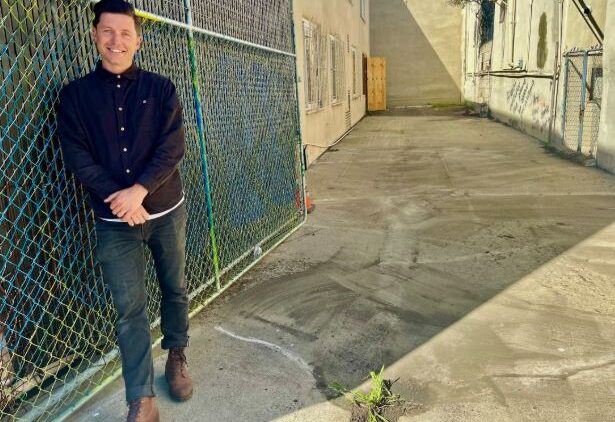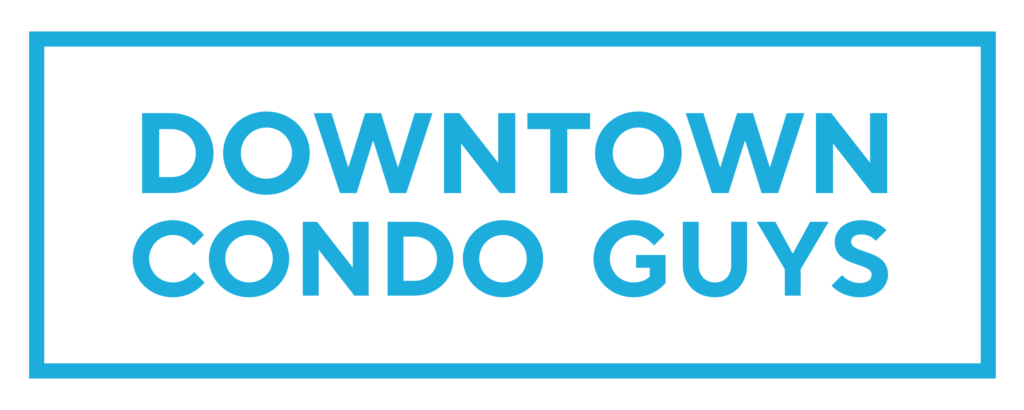
Nate Cadieux standing in the alley of Light Church that he plans to “activate.” (By Frank Sabatini Jr.)
Building with a ‘Purpose’
Developer Nate Cadieux Bridges Communities to New Projects
By Frank Sabatini Jr.
The name of his local development firm says it all.
Since founding Purpose in 2017, the architecturally conscious Nate Cadieux has spearheaded projects that include the mixed-use historic Waldorf building in North Park, the ongoing remodel of Light Church in Bankers Hill, plus others. More developments are currently in the pipeline.
Prior to starting the business, he worked for the McMillin company and was involved with its luxury apartment building in Little Italy called Eighteen Ten State Street He also helped develop under McMillin the north end of Liberty Station before it became the thriving arts and commercial center it is today.
Cadieux’s primary goal as a developer and investor is to create spaces that activate the community, whether it be socially, spiritually, commercially, or a combination thereof.
Structures that are imposing and institutional aren’t his thing. And that gave us good reason to chase him down for an informative chat about the rapid re-shaping of San Diego’s urban neighborhoods.
Downtown Condo Guys: How many projects have you overseen since starting Purpose? Are they exclusively in San Diego?
Cadieux: About 10, with some of them active right now. All of my projects have been in San Diego, and many are in North Park, where my wife and I are raising two kids.
Downtown Condo Guys: Can you discuss some of the “active” projects you’re working on currently?
Cadieux: I can talk about Light Church at 590 Ivy St. in Bankers Hills. Although I also have three projects that are on University Avenue and two large-scale projects just off of University. But I can’t release any details on those yet. I’m also looking for more adaptive-reuse projects in Bankers Hill where I want to convert office buildings into residential units, depending on the window lines and size of floor plates. We want buildings that can accommodate windows on both sides
Downtown Condo Guys: What are you doing specifically for Light Church?
Cadieux: We helped them acquire the building, which was built as a church in the 1920s. It’s now gutted for interior work. We’re bringing it back to its original historic architecture. In the 1970s the owners put a massive stucco facade over the original facade, which covered up the beautiful windows. We are going to remove the covering and restore those windows.
The work also includes putting in a sanctuary and a significant amount of kid space for Sunday school. We’ll be finished in about 12 to 18 months from now. Whenever we work with churches, we’re always looking for ways to invite the neighborhood into their spaces seven days a week instead of only on Sundays. At Light Church, for example, there is a private alley accessed from Sixth Avenue. We are going to turn it into three commercial/lease spaces for a coffee shop, an art gallery, and a retail store.
Downtown Condo Guys: What kind of transformation did you bring to the Waldorf in North Park?
Cadieux: I acquired the building in 2022 when it was partly operating as a gym. It was built in the 1930s and was originally called The Waldorf House of Television. We converted it into 11 units with two hospitality suites—one of them is occupied by Moniker Coffee and the other one will be a restaurant coming in May called Carne & Hueso.
Downtown Condo Guys: Do you have a preferred style of architecture?
Cadieux: I’m very much a minimalist, so I like simple, clean lines. When we’re doing adaptive reuse projects rather than from the ground up, I like celebrating their original architecture. Also, indoor/outdoor designs are critical for San Diego. And the mix of residential and commercial is powerful. Every project I do is going to have a mixed component because hospitality creates work and it creates connections to the community.
Downtown Condo Guys: Any particular structures in San Diego built by other developers that you admire?
Cadieux: A recent one is a project called The Parkline at 4250 Oregon St. in North Park by Andrew Malick of Malick Infill Development. It’s an apartment project built on an L-shape lot. I like it because of its great use of materials and the residential experience it provides. Andrew took this funky space and celebrated the buildings around it. The project looks like it almost surrounds the Chicken Pie Shop, but in a respectful way. He found a creative solution to a small, difficult lot.
I also like the work of architect-developer Jeff Svitak. His use of materiality and shape really stands out. It’s so cool. He just finished a project called Fora in North Park, which is 34 units. His use of glass and windows for the units have sliding glass doors that open to Juliette balconies. The living experience inside the suites is prioritized through them.
We are now doing a project with him and we’re in the midst of getting city approval to build a 125-unit apartment project with hospitality space on the ground floor on University Avenue in North Park. We’re being intentional about the design on the ground floor and have already engaged operators for food and beverage concepts. We see tremendous value activating the ground floor. It will be finished in 2026, which is all I can say about it right now.
Downtown Condo Guys: What types of building projects turn you off the most?
Cadieux: Projects that impede the pedestrian experience of a neighborhood. Although look at Little Italy, where the pedestrian experience is prioritized and successful.
Downtown Condo Guys: Do you see much potential for development in neighborhoods such as South Park and Golden Hill, which have remained largely untouched so far?
Cadieux: Yes, I think there is a way if the size of potential projects respect those neighborhoods. Any projects there would have to be small scale.
Downtown Condo Guys: What do you think San Diego’s urban landscape will look like in 10 years from now?
Cadieux: It will be very pedestrian-oriented compared to now. Most of the future development will support that. I definitely think that each individual neighborhood will have its own character, which I think is a good thing.


